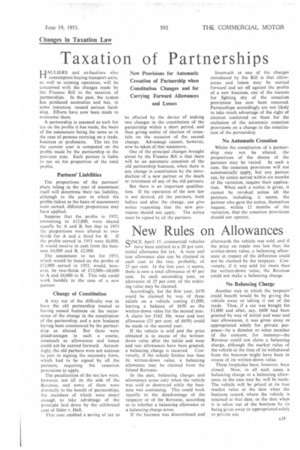New Rules on Allowances
Page 53

If you've noticed an error in this article please click here to report it so we can fix it.
QINCE April 15, commercial vehicles 0-1 have been entitled to a 20 per cent. initial allowance for tax.. A wear and tear allowance also can be claimed in each year at the rate, probably, of 25 per cent. In the first year, it seems, there is now a total allowance of 45 per cent. In each succeeding year, an allowance of 25 per cent. of the reducing value may be claimed, Accordingly, for the first year, £450 could he claimed by way of these reliefs on a vehicle costing £1,000., leaving a balance of £650 as the written-down value for the second year. A claim for £162 10s. wear and tear allowance (25 per cent. of £650) could be made in the second year.
If the vehicle is sold and the price obtained is in excess of the writtendown value after the initial and wear and tear allowances have been granted,
a balancing charge is incurred. Conversely, if the vehicle fetches less than its written-down value, a balancing allowance may be claimed from the Inland Revenue.
In the past, balancing charges and allowances arose only when the vehicle was sold or destroyed while the business was continuing. This could work equally to the disadvantage of the taxpayer or of the Revenue, according as to whether a balancing allowance or a balancing charge arose.
If the business was discontinued and afterwards the vehicle was sold, and if the price on resale was less than the written-down value, a balancing allowance in respect of the difference could not be claimed by the taxpayer. Conversely, if it was sold for more than the written-down value, the Revenue could not make a balancing charge.
No Balancing Charge
Another way in which the taxpayer could benefit' would be by giving the vehicle away or taking it out of the . trade. Thus, if a car was bought for £1,000 and after, say, £600 had been granted by way of initial and wear and tear allowances, it was given away or appropriated solely for private purposes—by a director or other member of the concern, for instance—the Revenue could not claim a balancing charge, although the market value of the vehicle at the time of its withdrawal from the business might have been in excess of its written-down value.
These loopholes have, however, been closed. Now, in all such cases, a balancing charge or a balancing allowance, as the case may be, will be made. The vehicle will be priced at its true market value at the date when the business ceased, where the vehicle is retained at that date, or the date when it is taken out of the business by its being given away or appropriated solely to private use.




















































































